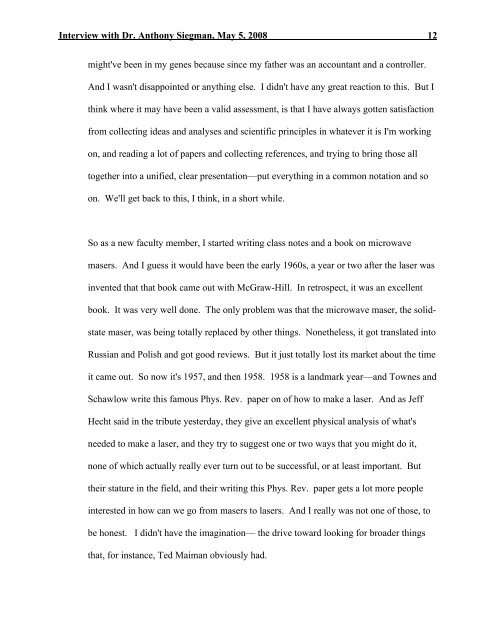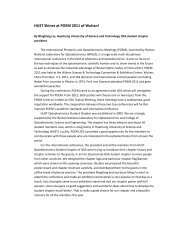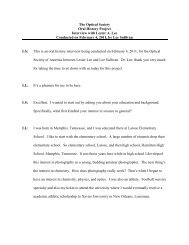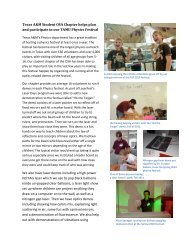The Optical Society Oral History Project Interview with ... - OSA
The Optical Society Oral History Project Interview with ... - OSA
The Optical Society Oral History Project Interview with ... - OSA
Create successful ePaper yourself
Turn your PDF publications into a flip-book with our unique Google optimized e-Paper software.
<strong>Interview</strong> <strong>with</strong> Dr. Anthony Siegman, May 5, 2008 12<br />
might've been in my genes because since my father was an accountant and a controller.<br />
And I wasn't disappointed or anything else. I didn't have any great reaction to this. But I<br />
think where it may have been a valid assessment, is that I have always gotten satisfaction<br />
from collecting ideas and analyses and scientific principles in whatever it is I'm working<br />
on, and reading a lot of papers and collecting references, and trying to bring those all<br />
together into a unified, clear presentation—put everything in a common notation and so<br />
on. We'll get back to this, I think, in a short while.<br />
So as a new faculty member, I started writing class notes and a book on microwave<br />
masers. And I guess it would have been the early 1960s, a year or two after the laser was<br />
invented that that book came out <strong>with</strong> McGraw-Hill. In retrospect, it was an excellent<br />
book. It was very well done. <strong>The</strong> only problem was that the microwave maser, the solidstate<br />
maser, was being totally replaced by other things. Nonetheless, it got translated into<br />
Russian and Polish and got good reviews. But it just totally lost its market about the time<br />
it came out. So now it's 1957, and then 1958. 1958 is a landmark year—and Townes and<br />
Schawlow write this famous Phys. Rev. paper on of how to make a laser. And as Jeff<br />
Hecht said in the tribute yesterday, they give an excellent physical analysis of what's<br />
needed to make a laser, and they try to suggest one or two ways that you might do it,<br />
none of which actually really ever turn out to be successful, or at least important. But<br />
their stature in the field, and their writing this Phys. Rev. paper gets a lot more people<br />
interested in how can we go from masers to lasers. And I really was not one of those, to<br />
be honest. I didn't have the imagination— the drive toward looking for broader things<br />
that, for instance, Ted Maiman obviously had.







